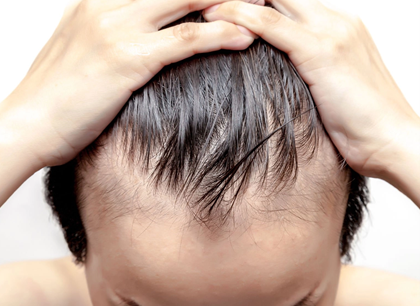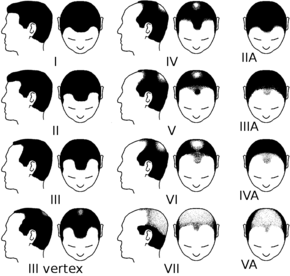Journal
Male Pattern Baldness
2024-04-23
Hair Transplant

Male Pattern Hair Loss
Male pattern baldness and female pattern baldness share some similarities, but they also have notable differences.
Male pattern baldness, also known as ‘androgenic/ androgenetic alopecia’ is the most common cause of hair loss in men.
Male pattern baldness, characterized by hair loss beginning at the hairline above the temples and progressing to a receding hairline, is typically succeeded by thinning hair on the crown of the head, resulting in a distinctive horseshoe-shaped pattern of remaining hair.
This pattern of hair loss is progressive and have seven stages you may go through slowly for years. Normally you can notice the early stages in your 30s, but sometimes you can have signs already at late teens or early 20s.
The Hamilton-Norwood scale delineates seven stages of male pattern baldness:

Stage 1: Hair loss or hairline recession is minimal or absent.
Stage 2: Hair loss is minor, typically affecting the area between the ears and forehead (temples).
Stage 3: Hairline recession deepens around the temples, often forming an "M" or "U" shape.
Stage 4: Hairline recession becomes pronounced, accompanied by significant hair loss at the crown of the head.
Stage 5: Hairline recession merges with the bald area at the crown.
Stage 6: Hair between the temples and crown thins or disappears.
Stage 7: Complete baldness on the crown with a narrow band of hair remaining around the sides of the head.
Male pattern baldness typically spares the eyebrows, eyelashes, and hair on the sides and back of the head from falling out. Hair loss in these regions commonly stems from other medical conditions.
What are the most common causes of male pattern baldness?
l Age:
As individuals age, it's common to notice a decrease in hair fullness due to the gradual slowing of hair growth. Male pattern baldness results from a combination of this reduced growth rate and genetic predispositions.
l Hormones:
This form of hair loss is related to androgens, hormones that help to control hair growth cycle.
Dihydrotestosterone (DHT) belongs to the group of androgens, which are a set of sex hormones facilitating puberty and physical maturation. These developments entail hair growth in various areas such as the face, scalp, chest, underarms, and genitals. Medical experts and researchers speculate about a potential connection between DHT and the shrinking of hair follicles.
l Genetics:
Research suggests that genetics account for roughly 80% of instances of male pattern baldness. This kind of baldness is a genetic disorder that is triggered by the genes you got from both side of your family. Researchers believe that a specific gene may influence the sensitivity of hair follicles to a hormone known as DHT, causing them to shrink. This shrinkage results in finer, thinner, and shorter hair regrowth. Over time, the hair growth cycle lengthens, and eventually, the follicles may shrink to the point where no hair grows at all.
l Other causes:
If your hair suddenly falls out rather than gradually thinning over time, it's typically attributed to factors other than male pattern baldness. Other potential causes include:
- illness or severe physical and emotional stress
- side effects of medical treatments
- vitamin deficiency and etc.
How to treat male pattern baldness?
Treatment for male pattern baldness include medications, PRP and a hair transplantation.
Medications
Topical minoxidil and finasteride are the only FDA approved treatments for male pattern baldness.
Topical over-the-counter (OTC) medications like minoxidil (Rogaine®) are typically the initial treatment option for male pattern baldness when applied to the scalp.
Side effects of minoxidil may encompass headaches, scalp irritation, and atypical hair growth. Alternatively, prescription oral medications like finasteride
(Propecia®) can also address male pattern baldness. Potential side effects may involve allergic reactions, testicular discomfort, and erectile dysfunction.
How soon after treatment will I feel better?
It may require two to four months of consistent daily application of minoxidil before you observe any improvement in your hair loss. Similarly, finasteride may necessitate at least three months of daily usage before any improvement becomes apparent. If you discontinue the use of either medication, the regrown hair is likely to shed.
Platelet-rich plasma (PRP)
A healthcare provider withdraws blood from your body, processes it, and administers it via injection into your scalp to encourage hair growth. Possible side effects may involve scalp discomfort and irritation, as well as feelings of dizziness, nausea, and vomiting.
This type of treatment is not permanent. If you want to maintain results, you need to keep getting treatment.
How soon after treatment will I feel better?
Recovery from platelet-rich plasma injections typically requires at least three weeks. Additional injections may be necessary to sustain the achieved results.
Hair transplantation
A healthcare provider takes skin grafts from areas of your body that contain healthy hair and moves them to bald or thinning areas of your scalp. You can read more about this procedure here.
If you are looking for a permanent solution, hair transplant is recommended. Nowadays this kind of surgery provides permanent and natural-looking results.
How soon after treatment will I feel better?
Recovery from a hair transplant generally takes a minimum of three weeks, with the full results potentially taking up to a year to become visible. Additional “touch-up” hair transplant procedures may be required to achieve a natural-looking outcome.
However, these interventions are not obligatory and should be pursued based on individual preference. Consulting with a doctor is advisable to determine the most suitable option.
If you have any symptoms of male pattern baldness that were described above, it would be better for you to see doctor for consultation sooner rather than later.
You can not prevent male pattern baldness because it is hereditary. But some of treatments for this type of baldness are more effective when the hair loss is still mild.
You could get to know which treatment is more appropriate in your case after having a consultation with a doctor. Docfinderkorea will help you find the best clinic in Korea and the hair care method that makes you feel better about how you look. If you want to get a free consultation, click here.
Back


